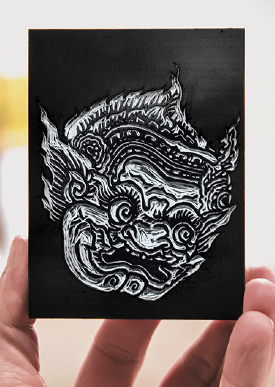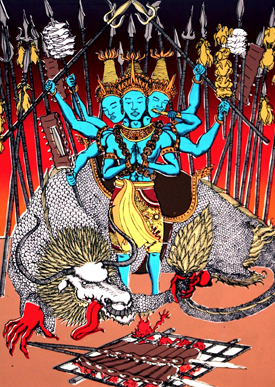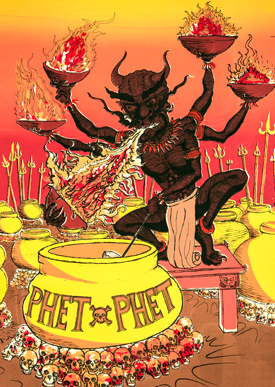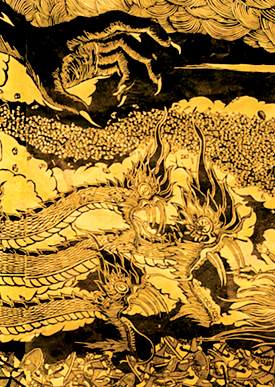Artist in Residence Raj Bunnag
[rev_slider Bunnag1]
When Raj Bunnag ’07 was young he doodled constantly—in notebooks, on his school papers, on anything in reach. Later, as an art student at Montgomery College, he honed printmaking skills—drawing, carving, inking, and using various methods to reproduce his doodles, which, by then, were conceptual and elaborate designs.
“Raj was one of those students I’d find waiting in the mornings for the print shop door to be opened,” says Art Professor John Carr, “and he was often the last to leave in the evenings. Sometimes he’d follow me to my truck, asking questions the entire way.”
Carr is proud of his former student’s accomplishments: Bunnag earned a BFA in printmaking from Maryland Institute College of Art (MICA), cum laude. He helps run a fine art, community-based print shop in North Carolina, participates in juried printmaking exhibitions, teaches printmaking, and mentors upcoming artists. This spring, he was the featured artist at RUNAWAY, a Durham shop/gallery. The fact that Bunnag is making a career in fine art printing is what impresses Carr most: “You don’t see jobs in the world of printmaking advertised in the Washington Post.”

Ink is rolled onto the carved surface using a brayer (roller). Pressure is then applied to transfer the image onto another surface. Photo by Pete Vidal.
The Art Department at Rockville invited Bunnag back to campus last February as the 2016 Artist in Residence. “We selected him,” says Carr, “because of his unique skills and techniques, and his ability to engage students and get them excited about the proposed project.”
During the residency, Bunnag worked with students in printmaking classes: World Woodcut and Relief Traditions, Printmaking Lithography, Intaglio Printmaking, and Monotype Workshop. He collaborated with them on a project inspired by Tibetan prayer flags, connecting printmaking to multi-culturalism and global awareness. The whole event would culminate in a gallery installation.
“Getting people interested in the arts is the best part about teaching,” he said. When John Carr called about the residency at Rockville, I was excited to come back to where it all started—where I really started to find out about this archaic art form—and where I found my artistic direction.”
During the first half of the three-week program, Bunnag demonstrated techniques for making linocuts, inking, and printing, and then worked with students to carve blocks for printing. During the second half, art professors Carr and Amanda Miller held open studios for all ARTT classes to print 10″ x 12″ flags using five pre-carved blocks: a 3″ x 4″ carrier image in the center surrounded by four smaller (3″ x 3″) corner images, a variety of solid-color fabric, special printing jigs, and black oil-based inks.
At the outset, Bunnag gave an Artist’s Talk in the gallery where his work was exhibited. At the closing reception, gallery-goers filled the space, which was by then festooned with the multicolored flags. Each one was unique, and overall they successfully integrated the visual influences of traditional prayer flags and contemporary icons and images. The flags were exhibited a second time on campus during the annual Art Walk, an outdoor art experience produced by the Art Department each April.
[envira-gallery id=”2506″]
Click on the thumbnail to view a larger image.
Raj Bunnag The Exhibition

Grilled Warrior is from Bunnag’s colorful screen-print series of food gods and showcases his comedic sensibility and his love of Hindu mythology.
As an art student at Maryland Institute College of Art, Raj Bunnag lived and worked in one of the country’s most disadvantaged cities: Baltimore. Outside of his campus and his student activities, he saw the city’s abandoned houses and blight. Drugs and violence were obviously responsible. Raised a Buddhist in Montgomery County by Thai immigrant parents who provided medical and charitable assistance in their homeland, Bunnag likened Baltimore to a third-world country. After moving to North Carolina with his wife, he channeled his emotional responses into a print series he calls March of the Druggernaughts: Fantastical Manifestations of the War on Drugs.
“The series,” says Bunnag, “is a playful social commentary on a serious subject—the illegal drug industry.” Conceptually, the scenes show compassion for humanity while hurling accusations against evil forces. Death—skeletons, grim reapers, and chains, smoke and flames—dance across his linocut prints in comic-book style—grinning and devious. They are frightening only in what they represent: real hell in real neighborhoods and lives.
In his colorful screen-print series of food gods, Bunnag showcases his comedic sensibility, his love of Hindu mythology, and his skill in printmaking. Soup Salad Goddess, a 15″ x 20″ screen print, required more than 10 layers to fully color. The fantasy continues in his Dessert Pastry God, Grilled Warrior, Curry Demon, Sauce Wiz, and Master of the Deep Fryer—each evokes equal measures of Eastern flavor and American farce.
“I usually do four or five sketches of a mockup,” says Bunnag. “I know in my head what I want.”
Once the drawing is on the block, however, he allows himself to sketch free form around his initial design, what he calls the centerpiece. He continues to build the images outward.
“This stage,” he says, “ultimately leads to an insatiable need to carve.”
The March of the Druggernaughts: Fantastical Manifestations of the War on Drugs and the Kitchen Gods series showcase Bunnag’s carving skills: the details are obsessive, minute, and intricate. Using a v-gouge, a hand-held carving tool that dates back to the late 15th century, he digs into the linoleum (his preferred medium), making tiny furrows and ruts. He controls the tool’s depth and direction, deciding which areas to excavate—these are the areas that create negative space—and which areas to leave as the printing surface.
“It’s a long process,” he says. “You don’t want to rush it.”
Murder Cartel Death Ride, a linocut print featuring a ravenous Godzilla-like creature surrounding by greedy machines and evil creatures, took Bunnag a full year to complete. His MICA thesis, Out of the Jungle It Came, a 2′ x 8′ linocut, took six months from start to finish. Later works have taken him several years from start to finish.
After carving, Bunnag rolls ink onto the surface using a brayer (roller), adds pressure, and voila! the image transfers. Peeling the cloth or paper away after each pressing, and viewing the reverse image for the first time is always exciting. Each print is a mirror-image of its original, but is also a handmade original—even though it is a reproduction, there is always the potential for small deviations.
While lost in carving—Bunnag’s universe becomes simultaneously riddled with ruin and whimsy, bones and gods, black ink and negative space. He forgets to eat, sleep, and check the time. As a working man, he can no longer afford too many all-nighters; he has to open a print shop and show others how it’s done. For him, there is an endless supply of art out there just needing some ink and a good press.
—Diane Bosser
[envira-gallery id=”2547″]
Click on the thumbnail to view a larger image.
About the Artist
Bunnag grew up in Montgomery County with strong ties to his family’s native Thailand. He earned a BFA in printmaking from Maryland Institute College of Art (2012). Since moving to Durham, NC, with his wife, Raina, Bunnag has enjoyed working with his “print hero,” Bill Fick, at Fick’s community-based fine art print shop, Supergraphic. In addition to producing his own work, he works on commission pieces, does freelance printing work, and teaches workshops, including short-term courses for Duke University’s DukeCreate program.





This person’s work is SO inspiring. Filled with creativity, as well as traditions. My personal madness about doing printmaking, (especially lithography),am delighted to see the photos of this artist, next to his “inked up” plate. Thank you for sharing these inspiring images. Hope that I too, may make some lithographs, at M.C. in 2016…It has been too long since I have had the amazing experience of “pulling a print.” VAR